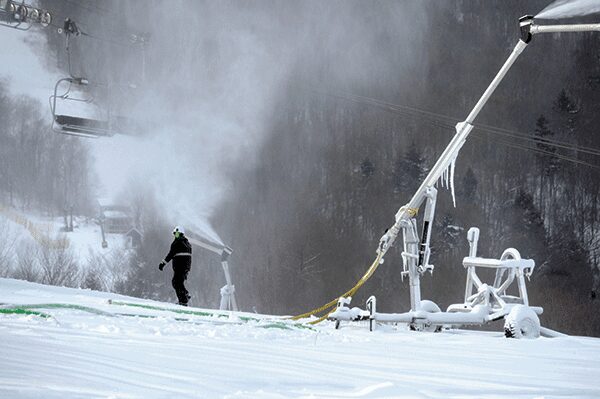Lifting the veil off the mysteries of snow.
Here in Vermont, snow is something we dream of, live by, and obsess over, so I set out to answer some questions that explain the inner workings of snow and snowmaking on the mountain. Questions like: Why is manmade snow more durable than natural snow? What’s a snowmaking whale? What’s wet bulb temperature versus dry bulb? Does the mountain have a heart? How do you improve snowmaking efficiency? And, for kicks, just how much snow could you make with all the water in Lake Champlain?
Snow: Natural vs. Manmade
Sure, natural snow and manmade snow are both made of the same thing: water. But their molecular structure—how that water is bonded—looks entirely different up close. A natural snowflake is made up of fragile little hexagons all fused together. It can be light and fluffy; and, once skied over, these flakes shatter and compress. Manmade snow, on the other hand, is composed of frozen water droplets. The flakes look like round pellets, have more structural integrity than snowflakes, and feel denser underfoot. In other words, it’s not just more snow that keeps Sugarbush’s snowmaking trails going into May, it’s the structure of that snow that allows it to last so long.
A Whale of a Tale
We’ve all come across them—giant snowmaking mounds, or “whales,” as they’re called in the industry, sitting along the entire width of a trail, blocking our view down the mountain. Some may think they are terrain park features (they can be), while others see a lapse in grooming. So why does the “whale” exist? We took the question to Sugarbush’s head of snowmaking operations, Mike Wing. “It’s all about drainage and freezing,” said Wing. “If we groom over freshly made snow, we’ll compress all the still-moist balls together. The result would be a hard, firm—even icy—surface. By giving the whales a couple of days to drain and freeze the moisture insulated inside, we preserve the integrity of the snow, so when we do groom, the results are a better overall experience for our guests.”
If the Mountain Had a Heart, It’d Be CB1
Much like your heart controls the flow of blood and oxygen to your body through a network of veins, Control Building 1, aka CB1, controls the flow of water and air to the mountain during snowmaking through a network of valves and plumbing. Need more snow to the Gate House side? Controllers stationed in CB1 will program computers to direct more water to the snow guns positioned on that side of the mountain to get the snow there. Is the temperature dropping, allowing for more water, less air, and better efficiency? Controllers in CB1 react accordingly by reducing the amount of air being produced in the plant.
Wet versus Dry Bulb—Same Temperature, Different Results
When is it possible to make snow at 39 degrees Fahrenheit? “When the humidity is at 10 percent or less,” says Wing. “Alternately, at 100 percent humidity, we can barely make snow even at 27 degrees.” The difference is in wet bulb versus dry bulb temperature. Dry bulb is the ambient air temperature, or what we traditionally measure with our home thermometers. Wet bulb combines the ambient air temperature with the relative humidity, and has a lower temperature reading than the dry bulb. Because humidity plays such a huge role in snowmaking, snowmakers use wet bulb readings to determine when to fire up the guns. In short, the dryer and colder the air, the better it is for snowmaking.
Snowmaking Efficiency
Water and compressed air are the two ingredients in snowmaking, with compressed air being the bigger energy consumer. But in recent years, the amount of energy required to make snow has been coming down, and the snow quality has been going up. Almost two million dollars of the newest technology will hit the slopes for the 2014–15 winter season, allowing Sugarbush to make more snow earlier in the season, and to use less compressed air and thus less energy. It’s a win for skiers, riders, and the environment.
Champlain Powder
Lake Champlain is the sixth-biggest lake in the United States and holds a whopping 6.8 trillion gallons of water. What could that make in snow? It takes 180,000 gallons of water to make 1 acre of snow, 1 foot deep. This means that Lake Champlain could cover more than 37.5 million acres with a foot of snow—or the entire state of Vermont (roughly 6.2 million acres) with over 6 feet of manmade powder.

